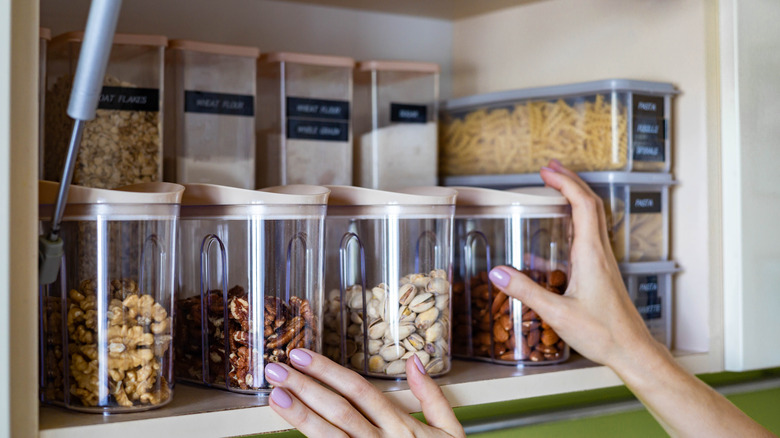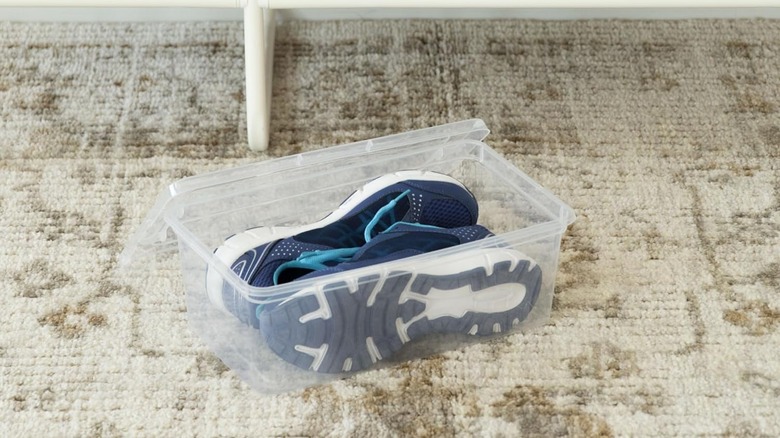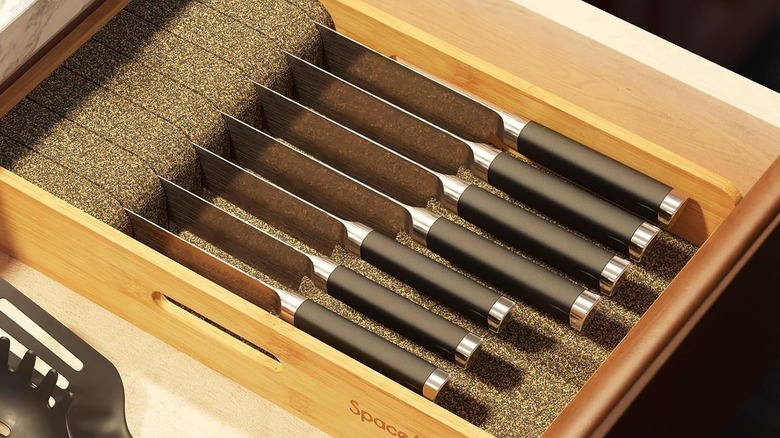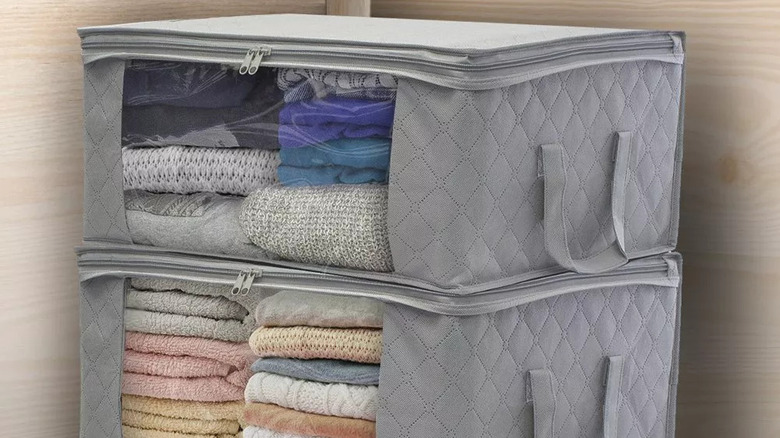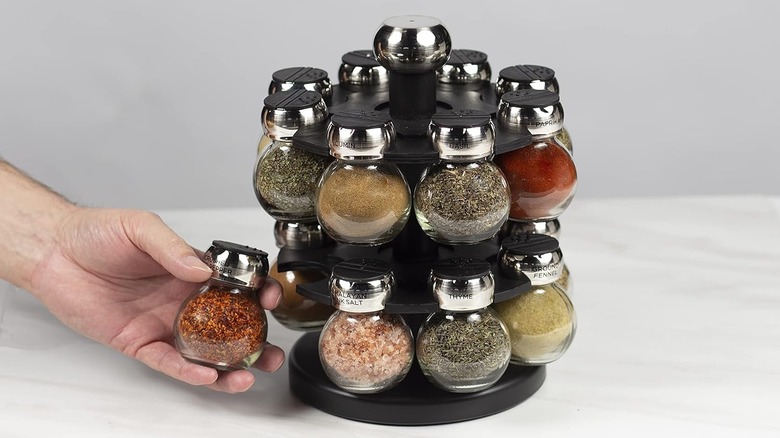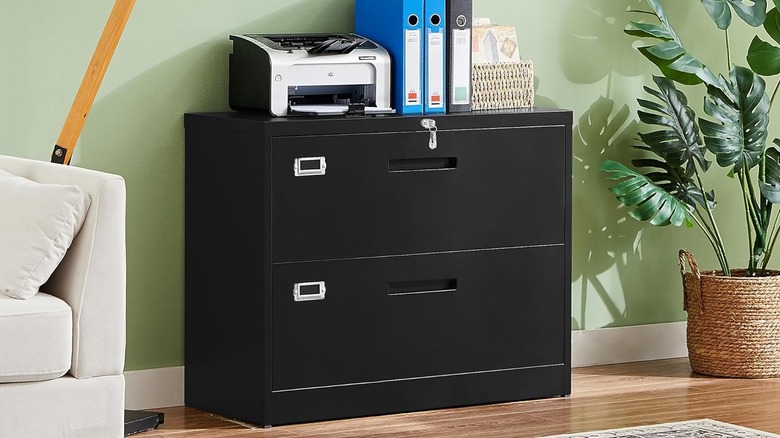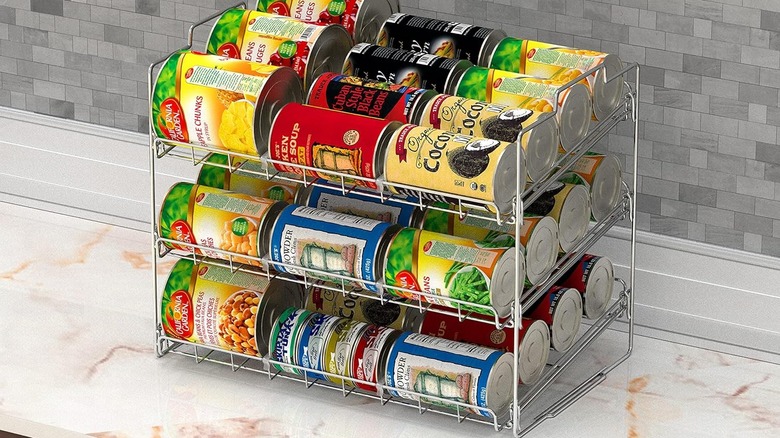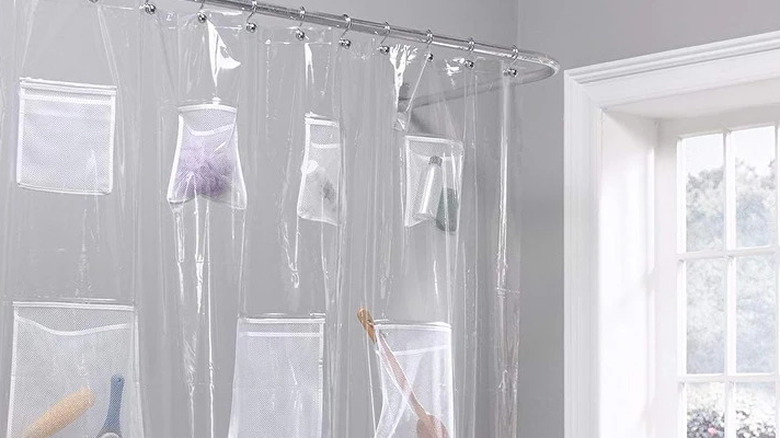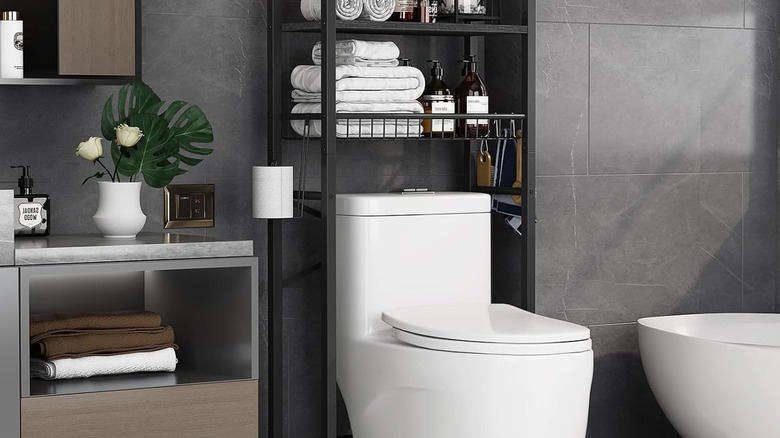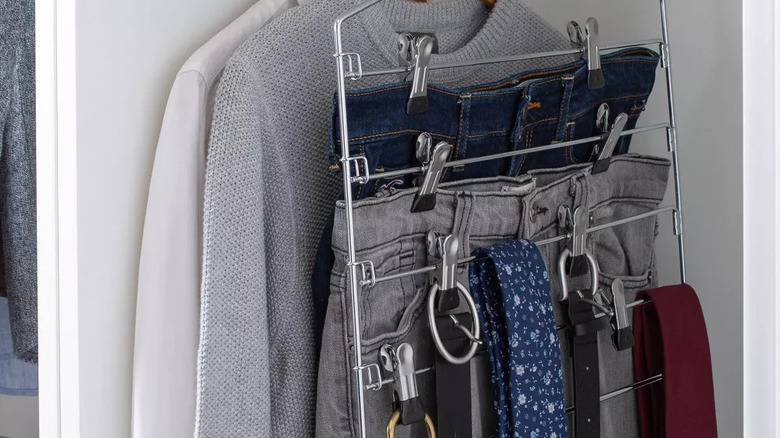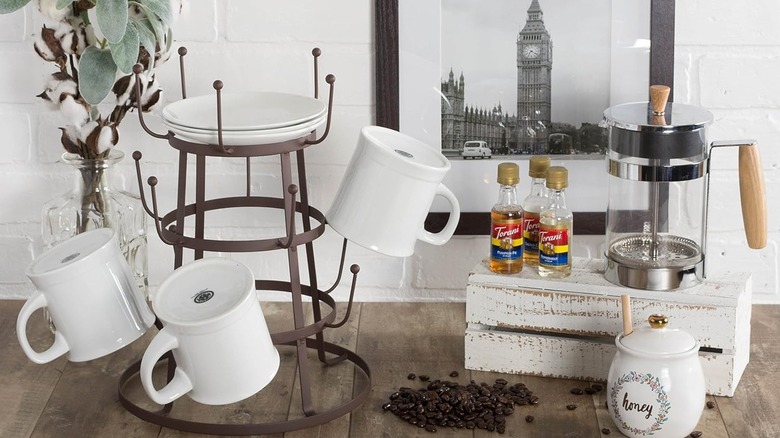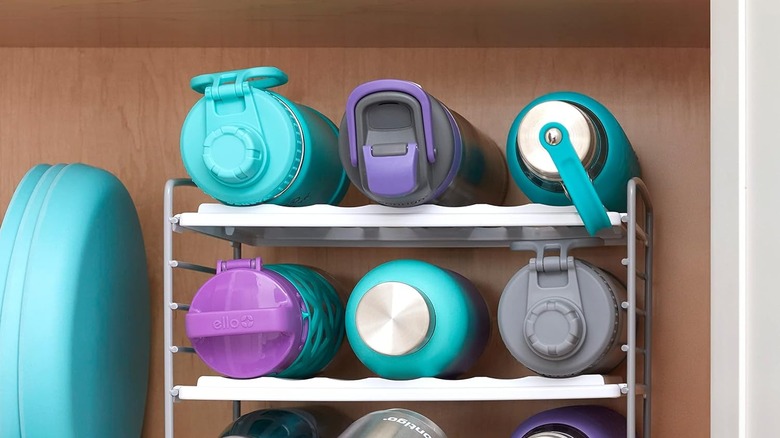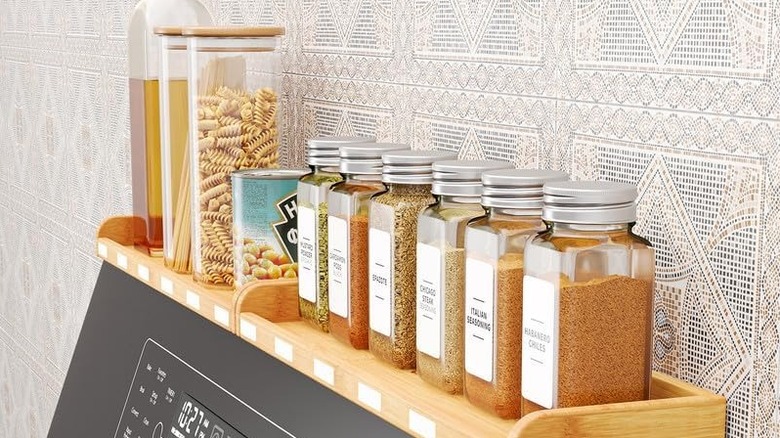Popular Home Storage Products That Aren't Worth Buying
We may receive a commission on purchases made from links.
The most ironic part about home organization is that buying storage products can leave things even more cluttered than before. You may think all those niche organization containers and tools are the solution to a disorderly household, when, in reality, many of these products are great in theory, but inefficient for everyday life.
Below are 13 popular home storage products that you should think twice about buying. Look past their glowing testimonials and high ratings on popular websites. Even if your favorite TikToker or Youtuber swears by it, consider whether the item fits into your lifestyle the same way. Many people pick up these items on impulse, happy to stock and store their new home storage tool. In the long run, though, will you want to keep this product clean, stocked, and organized? Plus, you may already have some baskets or boxes around the house you can repurpose, rather than spending money on something nearly identical. With these considerations in mind, check out our list of popular home storage products you might want to pass on.
Individual shoe boxes can use more space than shoe racks and shelves
Individual plastic shoe boxes are a popular way to preserve and protect footwear. Although they're good for putting shoes on display, they are one of the worst long-term storage solutions. When you lock shoes up in airtight boxes, the glue holding them together can dry up and break apart. Authentic leather or suede shoes are especially susceptible to damage, since these materials also need moisture to prevent cracking. On the flip side, plastic boxes also cause issues with moisture. If there's moisture locked in with shoes, they'll become moldy. The mold discolors material, leaves a foul odor, and makes your favorite pairs unsalvageable, if you don't realize it until too late.
Aside from potentially ruining your best pairs of boots, sandals, or sneakers, having too many individual shoe boxes could overwhelm your closet. An individual shoe box takes up a set amount of space and only fits one pair of shoes. On the other hand, shoe racks are more flexible. A simple shoe shelf allows you to pile up all shapes and sizes of footwear directly next to one another, saving space while also providing proper air circulation. Browse and keep track of your shoe collection by creating affordable shoe storage with these handy repurposing DIYs.
In-drawer knife blocks take up space and can encourage overspending
Bulky knife blocks are a common kitchen feature, and manufacturers now make in-drawer knife blocks to keep them off of countertops. These organizers seem ideal for those who love a tidy, clutter-free kitchen, but they take up most of a drawer. This is particularly an issue in small kitchens, as you may not have space to neatly organize other cooking utensils.
The blocks must be large enough to accommodate lengthy chef knives, often leaving space-wasting gaps. Not only do these blocks take up excessive space, but they can also encourage unnecessary spending. With multiple slots, you may think you need a whole collection of knives, but that might often not be the case. Downsizing your knife collection is a great way to reduce kitchen clutter and stay more organized without having to purchase any additional storage solutions. In fact, Anthony Bourdain wrote in Kitchen Confidential, "Here's all you will ever need in the knife department: ONE good chef's knife, as large as is comfortable for your hand." In-drawer knife blocks have several other cons: They're prone to bacteria, inaccessible while cooking, and don't hold other kitchen utensils.
Instead of using in-drawer knife blocks, opt for a more practical alternative. Magnetic wall strips are easy to access, clean, and keep organized. They're also versatile for holding other metal kitchen utensils. The Modern Innovations Stainless Steel Magnetic Knife Bar comes in various sizes, from 10 inches to 24 inches, making it a great fit for a variety of kitchens.
Glass and plastic organizer bins for groceries are tedious to keep up with
If you've ever delved into home improvement and decor trends, you've probably come across decanting on social media. This is a practice where people unload their groceries into aesthetically pleasing containers to make their refrigerators and pantries look like an ad, rather than an everyday kitchen. Grocery shopping is already tedious without having to unbox, repack, and label your entire haul. In addition to creating more work, removing food from its initial packaging jumpstarts the countdown to expiration. When you throw away original packaging, you toss cooking instructions, recipe recommendations, nutrition information, and important use-by dates. The matching containers are pleasingly uniform, but less distinguishable than the original packaging, making it potentially harder to find what you want. Bulk storage containers are also pricey and must be cleaned after each use.
Repacking groceries is often only practical for preserving bulk ingredients you've already opened and plan to reuse throughout the week, such as flour, sugar, cereals, and pastas. The key is not to decant all of your grocery items for the aesthetic, and to reserve this trend for a select few bulk items. This gives you time to properly label what's inside and add important dates. Try out this method with something like Vtopmart's Large Airtight Food Canisters, which are transparent and have reusable labels that make them versatile for holding different ingredients.
Plastic and non-woven clothing storage bags are flimsy
Plastic and non-woven storage bags don't assist with long-term storage; they only make it worse. Once stuffed with garments, they can be bulky and unwieldy. They're heavy to lift and their contents are jumbled by movement. The plastic exterior can sag in some places and get pulled taut in others, quickly creating a wrinkled mess of your clothes. They're also difficult to dig through, so the lack of access often leaves them forgotten in the back of closets.
Many garment storage bags are made of plastic and a non-woven fabric (another type of plastic in disguise), which don't allow air circulation. This is risky for leather and suede fabrics that are vulnerable to dryness. Or, if moisture somehow gets in the bag, there's danger of mold and mildew growth. It is possible to salvage some clothing items if you catch the problem early, however, mold growth is hard to notice in bags that are opaque and tucked out of sight.
Space-saving and organization are good priorities, but preserving your clothes should be your forefront concern. The best material to store them in is up for debate. If you're worried about pests, store them in airtight plastic containers with some silica packets to absorb moisture. For moisture or dryness concerns, store the clothes in breathable woven containers made of canvas, cotton, or linen.
Uniform spice racks don't fit all spice jars or other kitchen products
The internet is full of gorgeous spice racks that tuck into drawers, hang over cabinet doors, and spin on revolving bases. Although many of these racks appear organized and have decorative value, they aren't always practical in everyday kitchens. These spice towers and displays have identical slots for single-size containers. There's no flexibility for adding larger or square-shaped containers. Many come pre-filled and pre-labeled with the most popular spices, leaving no room to add unique and experimental seasonings. In addition to restricting your culinary experience, "complete" spice sets will likely have some ingredients you won't use.
Rather than purchasing a niche spice rack, pick an organizational tool that holds containers of all shapes and sizes. If you prefer ingredients concealed in a cabinet, try X-cosrack's 2 Pack Expandable Cabinet Countertop Shelves. These shelves extend to accommodate more space. If you prefer to keep some spices out on display, use Axtee's Lazy Susan Turntable Organizer. It's a standard revolving organizer that you can use for other home products, too.
Filing cabinets can clutter offices with unnecessary paper documents
Filing cabinets were once a household necessity. They were a safe place to preserve bills, financial statements, receipts, etc. Nowadays, banks keep most records for at least five years, insurance and medical companies keep electronic records, and billing statements are preserved online. You can even upload your own copies to cloud services and computer drives. These storage methods don't take up physical space, and the transition to electronic paperwork erases the need for bulky office cabinets.
Filing cabinets are not completely obsolete, and similar storage solutions are necessary for paper documents that should be kept in physical form. However, you can take a less space-consuming approach. Paper documents can be kept in a fire-proof safety box with other important things, or in something like Simple Houseware's Mesh Hanging File Organizer. This compact storage solution won't take up much space, and can be placed atop desks, in closets, or in a large desk drawer.
Can rack organizers tend to take up more space than traditional stacking methods
Rack-style organizers share many caveats with specialized spice racks. They're made with good intentions, but can be impractical compared to traditional storage methods. Multiple customers left reviews on Amazon stating the pantry can rack organizer pictured above doesn't fit on their shelves and is more bulky than it's worth. All grocery cans are not equally sized, meaning some won't fit on the lower shelves.
Also, it's usually easiest to load these organizers from the front or back. Therefore, the only way to keep older cans at the front is to either take out the whole rack or remove all the previously stocked cans when adding more pantry items. The rolling design also has a lot of gaps and wasted room, which is a problem for people trying to save space.
Overall, it might be more work to load and guide individual cans down a rolling rack, and more efficient to stack canned food the traditional way. If you still want an alternate storage solution, standard shelf inserts are the answer once again. Another option is YouCopia's ShelfSteps Can Organizer. Yes, this product also "wastes" space, but at least you can stock it quickly and with various-sized items.
Shower curtains with pockets are hotbeds for mold and mildew
Plastic shower curtains with pouches are a popular novelty storage solution. Since plastic curtains should be replaced every six months, it makes sense that manufacturers craft these out of cheap materials. However, the mass-produced material isn't sturdy and rips easily. The pockets can't hold heavy items, and it's risky to overload them. Standard tension curtain rods only hold up to 25 pounds. They already have to support the weight of the pocketed curtain and potentially another shower curtain or liner. When you fill multiple curtain pockets with 2 to 3-pound products, you could quickly exceed the weight limit. Additionally, even though mesh pockets are good for not absorbing water, moisture can still get trapped against the plastic and may linger in the spaces where the pockets connect to the curtain. This makes the curtains more susceptible to mold than designs without pockets and crevices.
Instead of buying a dangerous and short-lived shower curtain, use a different shower storage idea that keeps your favorite products within reach. A simple wire shower caddy, like the DAOYA 3-Tier Hanging Bathroom Shower Caddy, is just as accessible, easier to clean, and doesn't risk pulling your whole curtain setup down on top of you. The open wire design and stainless steel material is better at shedding water and resisting mold growth.
Over-the-toilet storage cabinets get in the way and aren't always sanitary
Over-the-toilet storage cabinets seem like a brilliant avenue to additional storage space, but that's not all there is to them. If a cabinet or drawer is left open, you risk smacking your head against it when at your most vulnerable on the toilet. When rifling through the cabinet's contents, you also risk knocking amenities over directly into the toilet bowl.
In addition to being an absolute nuisance for clumsy individuals, these cabinets are within a foot of the toilet. In an exclusive interview on whether over-the-toilet bathroom storage systems are sanitary, cleaning company owner Carly Castro told House Digest, "Researchers have found that every time a toilet is flushed (lid open or closed), microscopic viral particles can spread to 5 feet or more." An overhead cabinet is well within 5 feet, meaning these particles are spreading to the cabinets holding hygiene products, medication, and any other bathroom supplies.
Instead of installing an over-the-toilet storage cabinet, organize other areas of your bathroom to make room for overflow items (cleaning out clutter always helps, too!). Try saving bathroom space with DIY towel storage solutions or using other items to organize your bathroom belongings a little farther away from the toilet.
Tiered clothing and accessory hangers are bulky closet additions
It's hard not to fall into the trap of tiered clothing and accessory hangers. The multiple hooks and rungs on a single hanger may save space, but actually lead to more problems. These hangers tend to be lopsided unless you evenly distribute the weight of the accessories and clothes. The frontmost pieces block the ones behind them, making it hard to sift through a full hanger. They also become very heavy if you utilize all of the hooks and clasps, putting them at risk of snapping. There's also a chance they'll warp and break other parts of a closet system, especially if you're loading up a rail with multiple tiered hangers.
With all things considered, standard clothes hangers are probably still the way to go. The Sharpty Pant & Skirt Hangers are perfect for items you want to clip-hang, while the Amazon Basics Velvet Clothes Hangers are great for everything else (the velvet material makes them non-slip). If you have a vast collection of pants, shorts, and skirts, you can always fold or roll them in dresser drawers instead of hanging them. There are a thousand ways to organize accessories, but no one solution is best for everyone. Depending on how many belts, glasses, hats, purses, scarves, and other fashionable pieces you own, you'll need to get creative with organization. Try a hanging storage idea for organizing bags and invest in other multifunctional items you can use to organize your bedroom closet.
Mug trees can clutter countertops and collect dust
Mug trees have gone in and out of style over the decades. If you like the look, it's a great decorative feature for classic kitchens. However, it's not a great choice in terms of organization. These tiered cup holders make a display out of kitchen mug collections, often propping them sideways in a staggered formation. They're easily knocked over and take up unnecessary space, especially in small kitchens. Placing them out in the open also leaves them prone to dust buildup and insects.
There are several better organizational methods. If you enjoy building home solutions yourself, make a beautiful DIY wall display. You can also create more space for mug storage in cabinets by adding shelf risers or hanging them from Claimed Corner's Wall Mounted Mug Rack. Keep in mind that while mounted mug racks save countertop space, but are also as prone to dust and insects as mug trees. Another great option are the Aifeedi Coffee Mug Organizers — they're adjustable silicone "caps" you can use to stack mugs of all sizes to make the most of your cabinet shelves.
Water bottle storage racks have limited dimensions that don't fit all reusable bottles
Reusable water bottles have gained traction alongside sustainability awareness and, in doing so, have created a demand for more inessential consumerism: water bottle storage racks. This is another home storage item that is great in theory, but not in execution. Water bottles come in all shapes and sizes, and such a niche storage design can't accommodate the diversity. Many reviewers of these products complain that at least one or more of their water bottles are too long, short, or wide to fit in the racks. One verified purchaser of a stackable water bottle organizer corroborates this in their review, "I am still debating on whether or not to keep this. I feel like my bottles were better stored standing the way I had them."
Instead of purchasing this specialized home storage product, try other genius water bottle storage hacks to organize cabinets. Start by downsizing and getting rid of bottles that are worn out or rarely used. It's much easier to organize a smaller collection by simply arranging them in rows. If you don't want to part ways with your bottles, opt for multi-purpose home storage, such as the previously mentioned shelf dividers.
Stove shelves only fit niche designs and are too close to the heat
Installing a shelf right above a stovetop creates a handy storage space for your most used ingredients and cooking utensils. Despite its convenience, this kitchen feature is ultimately impractical. Splattering oils and cooking mishaps are bound to coat the shelf in residue, and you'll have to clean it often. Another issue is that the air around the stovetop inevitably warms up, and this heat will radiate to the shelf and its contents. You don't want to risk melting plastic or spoiling ingredients.
A stove shelf can also be dangerous for ceramic or glass cooktops. If you accidentally knock a heavy utensil or spice jar from the shelf, it could crack an expensive stove surface. Ceramic and glass cooktop owners aren't the only ones who should be wary — these shelfs don't fit all range designs. Online reviewers complain that some shelves don't fit their kitchens for various reasons; from the shelf blocking oven light switches to not fitting over curved back designs. If you want to have certain items out and close to the stove, instead of a cooking shelf over the back of your range, consider placing a couple of risers on the counter a few feet away. Something like these Songmics Kitchen Counter Shelves will be able to hold the same amount of things (if not more) in a way that's accessible but still corralled, organized, and not literally on top of the stove.
